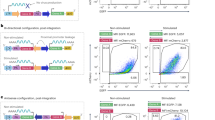Abstract
Current gene therapeutic protocols directed towards the treatment of inherited disorders (eg ADA-SCID) and viral infections (eg AIDS), as well as adoptive immunotherapy approaches are based on the use of genetically modified lymphocytes. Since only insufficient transduction of T cells is obtained using existing techniques, the development of more efficient gene transfer protocols into these cells is of great importance. We present here a protocol for the highly efficient transduction of human primary T cells at high densities (1 × 106/ml) by retroviral infection. Using retroviral vectors encoding a truncated human low-affinity nerve growth factor receptor (ΔLNGFR) as a gene transfer marker, we obtained transduction frequencies of more than 70% of CD3+ cells after two cycles of infection. Our protocol is based on the use of FBS-free media for both the production of retrovirus-containing supernatant and the cultivation of the primary T cells. Since the protocol presented here works just as efficiently under large-scale conditions, it may be easily adapted to clinical needs and ‘good manufacturing practice’ (GMP) standards.
This is a preview of subscription content, access via your institution
Access options
Subscribe to this journal
Receive 12 print issues and online access
$259.00 per year
only $21.58 per issue
Buy this article
- Purchase on Springer Link
- Instant access to full article PDF
Prices may be subject to local taxes which are calculated during checkout



Similar content being viewed by others
References
Blaese RM et al. T lymphocyte-directed gene therapy for ADA-SCID: initial trial results after 4 years Science 1995 270: 475–480
Rooney CM et al. Use of gene-modified virus-specific T lymphocytes to control Epstein–Barr-virus-related lymphoproliferation Lancet 1995 345: 9–13
Morgan RA, Walker R . Gene therapy for AIDS using retroviral mediated gene transfer to deliver HIV-1 antisense TAR and transdominant Rev protein genes to syngeneic lymphocytes in HIV-1 infected identical twins (clinical protocol) Hum Gene Ther 1996 7: 1281–1306
Bonini C et al. HSV-TK gene transfer into donor lymphocytes for control of allogeneic graft-versus-leukemia Science 1997 276: 1719–1724
Pollok KE et al. High-efficiency gene transfer into normal and adenosine deaminase-deficient T lymphocytes is mediated by transduction on recombinant fibronectin fragments J Virol 1998 72: 4882–4892
Fehse B et al. Highly-efficient gene transfer with retroviral vectors into human T lymphocytes on fibronectin (FN) Br J Haematol 1998 102: 566–574
Bunnell BA et al. High-efficiency retroviral-mediated gene transfer into human and nonhuman primate peripheral blood lymphocytes Proc Natl Acad Sci USA 1995 92: 7739–7743
Sharma S, Cantwell M, Kipps TJ, Friedmann T . Efficient infection of a human T-cell line and of primary peripheral blood leukocytes with a pseudotyped retrovirus vector Proc Natl Acad Sci USA 1996 93: 11842–11847
Rudoll T et al. High-efficiency retroviral vector mediated gene transfer into human peripheral blood CD4+ T lymphocytes Gene Therapy 1996 3: 695–705
Introna M et al. Rapid retroviral infection of human haemopoietic cells of different lineages: efficient transfer in fresh T cells Br J Haematol 1998 103: 449–461
Bunnell BA et al. Efficient in vivo marking of primary CD4+ T lymphocytes in nonhuman primates using a gibbon ape leukemia virus-derived retroviral vector Blood 1997 89: 1987–1995
Fehse B et al. Selective immunoaffinity-based enrichment of CD34+ cells transduced with retroviral vectors containing an intracytoplasmatically truncated version of the human low-affinity nerve growth factor receptor (ΔLNGFR) gene Hum Gene Ther 1997 8: 1815–1824
Fehse B et al. Impact of a new generation of gene transfer markers on gene therapy (editorial) Gene Therapy 1998 5: 429–430
Miller AD et al. Construction and properties of retrovirus packaging cells based on gibbon ape leukemia virus J Virol 1991 65: 2220–2224
Forestell SP, Böhnlein E, Rigg RJ . Retroviral end-point titer is not predictive of gene transfer efficiency: implications for vector production Gene Therapy 1995 2: 723–730
Miller DG, Adam MA, Miller AD . Gene transfer by retrovirus vectors occurs only in cells that are actively replicating at the time of infection Mol Cell Biol 1990 10: 4239–4242
Hanenberg H et al. Colocalization of retrovirus and target cells on specific fibronectin fragments increases genetic transduction of mammalian cells Nature Med 1996 2: 876–882
Kavanaugh MP et al. Cell-surface receptors for gibbon ape leukemia virus and amphotropic murine retrovirus are inducible sodium-dependent phosphate symporters Proc Natl Acad Sci USA 1994 91: 7071–7075
Hildinger M et al. Dominant selection of hematopoietic progenitor cells with retroviral MDR1-coexpression vectors Hum Gene Ther 1998 9: 33–42
Acknowledgements
We wish to thank Claudia Kielburger for excellent technical assistance. We are indebted to the blood banks of the University Hospital Eppendorf and DRK Bad Kreuznach as well as Richard Morgan and his group at the NIH for kind co-operation. This work was supported by a grant of the Bundesministerium für Bildung und Forschung (01KV9531). BF’s stay at the NIH was supported by a travel grant from the German American Academic Council.
Author information
Authors and Affiliations
Rights and permissions
About this article
Cite this article
Ayuk, F., Li, Z., Kühlcke, K. et al. Establishment of an optimised gene transfer protocol for human primary T lymphocytes according to clinical requirements. Gene Ther 6, 1788–1792 (1999). https://doi.org/10.1038/sj.gt.3300999
Received:
Accepted:
Published:
Issue Date:
DOI: https://doi.org/10.1038/sj.gt.3300999
Keywords
This article is cited by
-
Self-inactivating retroviral vectors with improved RNA processing
Gene Therapy (2004)
-
Recombinant Sendai virus vectors for activated T lymphocytes
Gene Therapy (2003)
-
A novel ‘sort-suicide’ fusion gene vector for T cell manipulation
Gene Therapy (2002)
-
Gene-based cancer vaccines: an ex vivo approach
Leukemia (2001)



